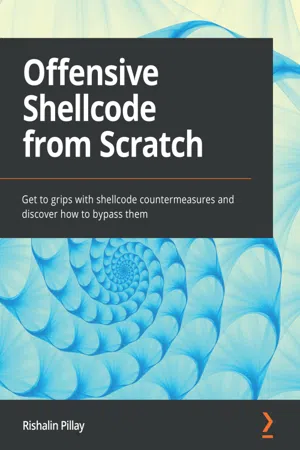
Offensive Shellcode from Scratch
Rishalin Pillay
- 208 pagine
- English
- ePUB (disponibile sull'app)
- Disponibile su iOS e Android
Offensive Shellcode from Scratch
Rishalin Pillay
Informazioni sul libro
Gain practical knowledge of shellcode and leverage it to develop shellcode for Windows and Linux operating systems, while understanding the countermeasures in place and how these can be bypassedKey Features• Get up and running with shellcode fundamentals• Develop Shellcode for Windows and Linux• Understand the building blocks of shellcodeBook DescriptionShellcoding is a technique that is executed by many red teams and used in penetration testing and real-world attacks. Books on shellcode can be complex, and writing shellcode is perceived as a kind of "dark art." Offensive Shellcode from Scratch will help you to build a strong foundation of shellcode knowledge and enable you to use it with Linux and Windows. This book helps you to explore simple to more complex examples of shellcode that are used by real advanced persistent threat (APT) groups. You'll get to grips with the components of shellcode and understand which tools are used when building shellcode, along with the automated tools that exist to create shellcode payloads. As you advance through the chapters, you'll become well versed in assembly language and its various components, such as registers, flags, and data types. This shellcode book also teaches you about the compilers and decoders that are used when creating shellcode. Finally, the book takes you through various attacks that entail the use of shellcode in both Windows and Linux environments. By the end of this shellcode book, you'll have gained the knowledge needed to understand the workings of shellcode and build your own exploits by using the concepts explored.What you will learn• Gain a thorough understanding of shellcode• Get to grips with assembly language and its key purpose in shellcode development• Identify key elements of memory registers• Explore debuggers and their use cases• Get up and running with hands-on shellcode creation for both Windows and Linux• Exploit Windows and Linux operating systems using shellcode• Assess countermeasures of Windows and LinuxWho this book is forThis book is for red teamers, penetration testers, and anyone looking to learn about shellcode and find out how it is used to break into systems by making use of simple to complex instructions of code in memory. Basic shellcode knowledge is helpful but not mandatory to understand the topics covered in this book.
Domande frequenti
Informazioni
Section 1: Shellcode
- Chapter 1, The Ins and Outs of Shellcode
- Chapter 2, Assembly Language
- Chapter 3, Shellcode Tools and Resources
Chapter 1: The Ins and Outs of Shellcode
- What is shellcode?
- Breaking down shellcode
- Exploring the common types of shellcode
What is shellcode?
Examples of shellcode
Indice dei contenuti
- Offensive Shellcode from Scratch
- Contributors
- Preface
- Section 1: Shellcode
- Chapter 1: The Ins and Outs of Shellcode
- Chapter 2: Assembly Language
- Chapter 3: Shellcode Tools and Resources
- Section 2: Writing Shellcode
- Chapter 4: Developing Shellcode for Windows
- Chapter 5: Developing Shellcode for Linux
- Section 3: Countermeasures and Bypasses
- Chapter 6: Countermeasures and Bypasses
- Other Books You May Enjoy